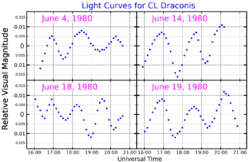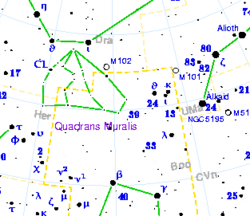Astronomy:CL Draconis
CL Draconis (circled), with the obsolete constellation Quadrans Muralis in the background. | |
| Observation data Equinox J2000.0]] (ICRS) | |
|---|---|
| Constellation | Draco |
| Right ascension | 15h 57m 47.44180s[1] |
| Declination | +54° 44′ 59.1428″[1] |
| Apparent magnitude (V) | 4.96[2] |
| Characteristics | |
| Spectral type | F0 IV[3] |
| B−V color index | 0.269±0.008[2] |
| Variable type | δ Sct[4] |
| Astrometry | |
| Radial velocity (Rv) | −11.0±4.2[5] km/s |
| Proper motion (μ) | RA: −151.643[1] mas/yr Dec.: +107.519[1] mas/yr |
| Parallax (π) | 29.9305 ± 0.1368[1] mas |
| Distance | 109.0 ± 0.5 ly (33.4 ± 0.2 pc) |
| Absolute magnitude (MV) | 2.33[2] |
| Details | |
| Mass | 1.68±0.01[6] M☉ |
| Luminosity | 10.2+0.2 −0.3[6] L☉ |
| Surface gravity (log g) | 4.04±0.14[7] cgs |
| Temperature | 7,439±253[7] K |
| Metallicity [Fe/H] | 0.04±0.10[8] dex |
| Rotational velocity (v sin i) | 165[6] km/s |
| Age | 643[7] Myr |
| Other designations | |
| Database references | |
| SIMBAD | data |
CL Draconis is a single[10] star in the northern circumpolar constellation of Draco. It can be viewed with the naked eye, having an apparent visual magnitude of 4.96.[2] The distance to this star, as determined from its annual parallax shift of 29.9 mas,[1] is 109 light years. It is moving closer to the Earth with a heliocentric radial velocity of −11 km/s.[5] The star has a relatively high proper motion, traversing the celestial sphere at the rate of 0.185″/yr.[11]
Based upon a stellar classification of F0 IV,[3] this is an aging F-type subgiant star that has consumed the hydrogen at its core. It is spinning rapidly with a projected rotational velocity of 165 km/s,[6] giving it an oblate shape with an equatorial bulge that is estimated to be 8% larger than the polar radius.[12]

CL Draconis is a Delta Scuti variable, changing brightness with an amplitude of 0.010 magnitude over a period of 1.83 hours.[14] CL Dra has 1.68[6] times the mass of the Sun and is radiating 10.2[6] times the Sun's luminosity from its photosphere at an effective temperature of 7,439 K.[7]
It was transferred from Draco to Quadrans Muralis. Later when the International Astronomical Union officially recognised constellations, Quadrans Muralis became obsolete, so this star was moved back to Draco.
References
- ↑ Jump up to: 1.0 1.1 1.2 1.3 1.4 1.5 Brown, A. G. A. (August 2018). "Gaia Data Release 2: Summary of the contents and survey properties". Astronomy & Astrophysics 616: A1. doi:10.1051/0004-6361/201833051. Bibcode: 2018A&A...616A...1G.
- ↑ Jump up to: 2.0 2.1 2.2 2.3 Anderson, E.; Francis, Ch. (2012), "XHIP: An extended hipparcos compilation", Astronomy Letters 38 (5): 331, doi:10.1134/S1063773712050015, Bibcode: 2012AstL...38..331A.
- ↑ Jump up to: 3.0 3.1 Cowley, A. et al. (April 1969), "A study of the bright A stars. I. A catalogue of spectral classifications", Astronomical Journal 74: 375–406, doi:10.1086/110819, Bibcode: 1969AJ.....74..375C.
- ↑ Samus', N. N; Kazarovets, E. V; Durlevich, O. V; Kireeva, N. N; Pastukhova, E. N (2017), "General catalogue of variable stars: Version GCVS 5.1", Astronomy Reports 61 (1): 80, doi:10.1134/S1063772917010085, Bibcode: 2017ARep...61...80S.
- ↑ Jump up to: 5.0 5.1 de Bruijne, J. H. J.; Eilers, A.-C. (October 2012), "Radial velocities for the HIPPARCOS-Gaia Hundred-Thousand-Proper-Motion project", Astronomy & Astrophysics 546: 14, doi:10.1051/0004-6361/201219219, A61, Bibcode: 2012A&A...546A..61D.
- ↑ Jump up to: 6.0 6.1 6.2 6.3 6.4 6.5 Zorec, J.; Royer, F. (2012), "Rotational velocities of A-type stars. IV. Evolution of rotational velocities", Astronomy & Astrophysics 537: A120, doi:10.1051/0004-6361/201117691, Bibcode: 2012A&A...537A.120Z
- ↑ Jump up to: 7.0 7.1 7.2 7.3 David, Trevor J.; Hillenbrand, Lynne A. (2015), "The Ages of Early-Type Stars: Strömgren Photometric Methods Calibrated, Validated, Tested, and Applied to Hosts and Prospective Hosts of Directly Imaged Exoplanets", The Astrophysical Journal 804 (2): 146, doi:10.1088/0004-637X/804/2/146, Bibcode: 2015ApJ...804..146D.
- ↑ Gáspár, András et al. (August 2016), "The Correlation between Metallicity and Debris Disk Mass", The Astrophysical Journal 826 (2): 14, doi:10.3847/0004-637X/826/2/171, 171, Bibcode: 2016ApJ...826..171G.
- ↑ "CL Dra". SIMBAD. Centre de données astronomiques de Strasbourg. http://simbad.u-strasbg.fr/simbad/sim-basic?Ident=CL+Dra.
- ↑ Eggleton, P. P.; Tokovinin, A. A. (2008), "A catalogue of multiplicity among bright stellar systems", Monthly Notices of the Royal Astronomical Society 389 (2): 869, doi:10.1111/j.1365-2966.2008.13596.x, Bibcode: 2008MNRAS.389..869E.
- ↑ Lépine, Sébastien; Shara, Michael M. (March 2005), "A Catalog of Northern Stars with Annual Proper Motions Larger than 0.15" (LSPM-NORTH Catalog)", The Astronomical Journal 129 (3): 1483–1522, doi:10.1086/427854, Bibcode: 2005AJ....129.1483L.
- ↑ van Belle, Gerard T. (March 2012), "Interferometric observations of rapidly rotating stars", The Astronomy and Astrophysics Review 20 (1): 51, doi:10.1007/s00159-012-0051-2, Bibcode: 2012A&ARv..20...51V.
- ↑ DuPuy, D. L.; Burgoyne, L. G. (January 1983). "HR 5960: new observations and period search". Publications of the Astronomical Society of the Pacific 95: 61–68. doi:10.1086/131118. Bibcode: 1983PASP...95...61D.
- ↑ Rodríguez, E. et al. (June 2000), "A revised catalogue of δ Sct stars", Astronomy and Astrophysics Supplement 144 (3): 469–474, doi:10.1051/aas:2000221, Bibcode: 2000A&AS..144..469R.
 |


